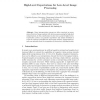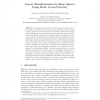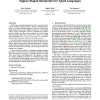10048 search results - page 48 / 2010 » The Structure and Performance of Interpreters |
KI
2008
Springer
13 years 9 months ago
2008
Springer
Abstract. Scene interpretation systems are often conceived as extensions of low-level image analysis with bottom-up processing for high-level interpretations. In this contribution ...
ICML
2008
IEEE
14 years 10 months ago
2008
IEEE
Discovering additive structure is an important step towards understanding a complex multi-dimensional function because it allows the function to be expressed as the sum of lower-d...
IJCNN
2007
IEEE
14 years 3 months ago
2007
IEEE
— We present a computational model of human category learning that learns the essential structures of the categories by forgetting information that is not useful for the given ta...
CC
2007
Springer
14 years 3 months ago
2007
Springer
As the amount of data used by programs increases due to the growth of hardware storage capacity and computing power, efficient memory usage becomes a key factor for performance. Si...
ICFP
2002
ACM
14 years 9 months ago
2002
ACM
Multi-stage programming languages provide a convenient notation for explicitly staging programs. Staging a definitional interpreter for a domain specific language is one way of de...



